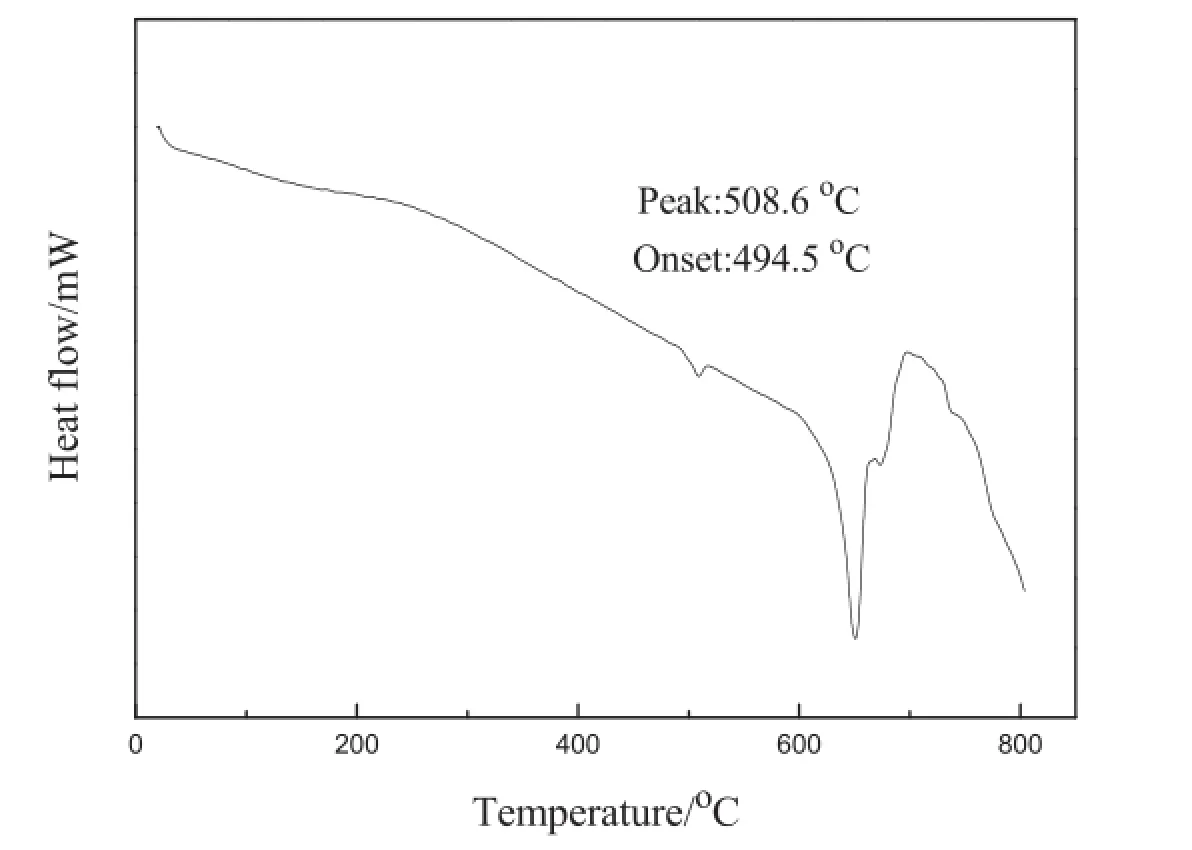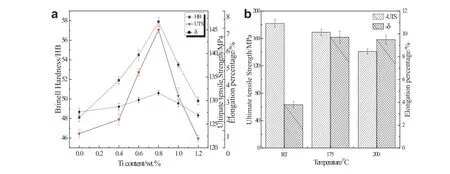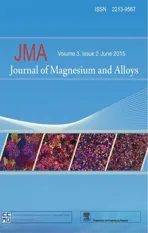Effects of Ti addition on the microstructure and mechanical properties of Mg-Zn-Zr-Ca alloys
2015-02-16*
*
College of Materials Science and Engineering,Taiyuan University of Technology,Taiyuan 030024,China
Effects of Ti addition on the microstructure and mechanical properties of Mg-Zn-Zr-Ca alloys
Jingai Chen,Yan Sun,Jinshan Zhang*,Weili Cheng,Xiaofeng Niu,Chunxiang Xu
College of Materials Science and Engineering,Taiyuan University of Technology,Taiyuan 030024,China
The effects of Ti additions(0,0.4,0.6,0.8,1.0,1.2 wt.%)on the microstructure and mechanical properties of as-cast and aging Mg-0.4%Zn-1.0%Zr-1.5%Ca(wt.%)alloys were investigated.The results indicated that minor Ti can effectively refne grains,while excessive Ti addition resulted in the grain coarsening.When the content of Ti was 0.8 wt.%,the as-cast alloy exhibited the fnest grain size of 39 μm which contributed to the optimal mechanical properties with Brinell hardness of 57.9 HB,ultimate tensile strength of 145 MPa and elongation of 3.2%.After T6 heat treatment,the continuous net-like Mg2Ca and Mg6Zn3Ca2phases changed to uniform massive T phases(ternary Mg-Zn-Ca phases)and dispersive halo-like precipitates(Mg2Ca and Mg6Zn3Ca2phases).The ultimate tensile strengths of the alloy at room temperature(RT),175°C and 200°C were correspondingly improved to 182 MPa,169 MPa and 141 MPa,respectively.
Ti;Magnesium alloys;Microstructure;Mechanical properties;Heat treatment
1.Introduction
Magnesium(Mg)alloys,as the lightest metallic structural materials,have great potential for aircraft,automotive and electronic industries due to their low density and high specifc strength.1-3The heat resistance of Mg alloys can be improved signifcantly by rare-earth(RE)element addition.4Australian Magnesium Corporation,in collaboration with the Cooperative Research Center for Cast Metals Manufacturing(CAST CRC)has developed a heat resistant Mg-RE based alloy,AMSC15(Mg-0.4 wt.%Zn-1.0 wt.%Zr-1.0 wt.%RE-1.7 wt.% Nd),which has been specifcally developed to serve at elevated temperature as engine block.However,the RE element addition increases the cost and limits the wide applications of RE-added Mg alloys.Previous research6investigated the effects of Ca addition on the microstructure and mechanical properties of Mg-0.4%Zn-1.0%Zr-2.0%RE (wt.%)alloy.The result indicated that the alloy containing 1.5 wt.%Ca showed the best mechanical properties.After T6 heat treatment,the ultimate tensile strength at 20°C,175°C and 200°C reached to 186 MPa,166 MPa and 140 MPa, respectively,with the corresponding elongations of 3.5%, 11.4%and 10.3%,respectively.
The alloy element Ti has been well accepted due to its effectiveness in grain refnement of not only Al-based and Mg-Al alloys,7-10but also Al-free Mg alloys.2,11,12Yang2demonstrated thatadditionsofminoramountsofTi (0.1-0.3 wt.%Ti)to Mg-3Sn-2Sr improved the creep properties of the cast alloy by refning the Mg-Sn phases. Buha11,12demonstrated that adding 0.8 wt.%Ti resulted in a pronounced grain-refning effect on Mg-Zn alloy.In addition, as a strong constitutional cooling element,Ti also can lead to grain refnement by accelerating nucleation.13However,as thestudy of Ti on the grain refnement of Mg-Zn-Zr based alloys is not suffcient,it would be effective to investigate the effect of Ti on the grain refnement of Mg-Zn-Zr based alloys.Therefore,the present work aims at replacing the RE element with Ti in the Mg-0.4%Zn-1.0%Zr-1.5%Ca-2.0%RE alloy to reduce the cost.It is also expected that Ti addition to Mg-0.4%Zn-1.0%Zr-1.5%Ca(wt.%)alloy is possibly benefcial to the microstructure refnement and properties improvement of the alloys.
2.Experimental
The Mg-0.4%Zn-1.0%Zr-1.5%Ca alloys with different Ti additions(0,0.4,0.6,0.8,1.0 and 1.2 wt.%)were processed under conventional casting condition by using pure Mg (99.9 wt.%),Zn(99.9 wt.%),Ti(99.9 wt.%),Mg-25 wt.%Ca master alloy and Mg-30 wt.%Zr master alloy.The alloys were melted in an electrical resistance furnace using a mild steel crucible under a mixed protection gas atmosphere of N2(97.4 vol.%)and CH2FCF3(2.6 vol.%).The melt was held at 740°C for 20 min to ensure the alloying elements to be completely dissolved and diffused.When the furnace temperature decreased to 710°C,the melted alloys were poured into a cylindrical steel mold which had been preheated to 200°C. The actual chemical compositions of the studied alloy are listed in Table 1,which were analysed by an inductivity coupled plasma atomic emission spectrometer.
Samples were given a T6 heat-treatment,solution-treated at 500°C for 7 h and aged at 200°C for 20 h in a SX2-8-10 box type high-temperature electric resistance furnace,followed by water quenching.The microstructural characterization was carried out by using a Leica DM2500 M optical microscope (OM).JSU-6700F scanning electron microscopy(SEM) equipped with an Oxford energy dispersive X-ray spectrometer(EDS)was used to study the morphological and microchemical characterization of second phases.Herein,standard metallographic samples preparation techniques were applied using a solution of 4 vol.%HNO3+96 vol.%ethanol.Grain size was measured by the lineal intercept method.Phase constitution analyses were performed with a Y-2000 X-ray diffractometer(XRD),using monochromatic Cu Kα radiation. Brinell hardness was measured by a HB-3000 Brinell hardness testing machine with load of 62.5 kg and loading time of 30 s. Tensile tests were carried out by a DNS100 universal testing machine with a crosshead speed of 0.5 mm/min.Thermalproperty of the alloy was studied via a HCT-2 differential scanning calorimeter with a heating rate of 10ºC/min.

Table 1The actual chemical compositions of the Mg-0.4%Zn-1.0%Zr-1.5%Ca-Ti alloys(wt.%).
3.Results and discussion
3.1.Microstructure
Fig.1 shows the microstructure of as-cast Mg-0.4%Zn-1.0%Zr-1.5%Ca alloys with different Ti additions.As shown in Fig.1(a),in Mg-0.4%Zn-1.0%Zr-1.5%Ca alloy,the α-Mg grains are mainly petal-like with the average size of about 82 μm.Some continuous network intermetallic phases and dispersive particle phases can be observed at the grain boundary and in the grain,respectively.Furthermore,the effect of Ti content on the grain size of as-cast Mg-0.4%Zn-1.0%Zr-1.5%Ca alloys has been studied.As shown in Fig.2, the grain size shows a trend that decreased frstly and then increased with the increasing of Ti content.When the content of Ti is 0.8 wt.%,the alloy shows the fnest grain size of 39 μm.However,the continuous network intermetallic phases and dispersive particle phases still exist.According to the achievements of Mark and David,14excellent segregation ability and effective nucleation particle are the key factors for grain refnement.Solute segregation tends to form intensive constitutional undercooling ahead of solid/liquid interface in diffusion layer,which promotes nucleation and limits the growth of α-Mg grain.Ti possesses strong segregation ability and low solid solubility in Mg matrix(0.02 wt.%at 650°C). Therefore,Ti atoms are rich in the solid/liquid interface during solidifcation,which leads to constitutional undercooling and promotes the formation of a nucleus.Besides,as a surface active element,Ti can inhibit the element diffusion and induce the constitution undercooling ahead of the solid/liquid interface.2According to the work by Bramftt,15one criterion for heterogeneous nucleation is that the disregistry of nucleant planes should be less than 15%.The crystal structure of Ti, which is same as Mg,is hexagonal close-packed(hcp).The lattice constants of Ti(aTi=0.2950 nm and cTi=0.4686 nm) are very close to those of Mg(aMg=0.3209 nm and cMg=0.5211 nm).16The lattice misft between Ti and Mg (δa=8.05%and δC=10.1%)is much less than 15%. Therefore,α-Ti can cause the heterogeneous nucleation of the α-Mg phase theoretically.Based on the Mg-Ti binary phase diagram,when the content of Ti increases to 0.02 wt.%,the peritectic reaction occurres at 650°C:L+(α-Ti)→(α-Mg).α-Ti can form by crystallization in the melt before peritectic transformation and then dispersive α-Mg phases nucleate on the surface of α-Ti.As temperature decreases,the small particles of α-Mg generated by peritectic reaction act as crystallization nuclei,while the primary α-Mg phase nucleates and grows.However,as shown in Fig.1(e)and(f),when the addition of Ti is more than 0.8 wt.%,the grains become coarser and coarser,which is mainly caused by excessive addition of Ti.The massive Ti particles in the melt would aggregate and grow up,thus the nucleation particles decrease, which greatly reduces the crystal nucleus and leads to the growth of the grains.17
The SEM images and corresponding EDS results of ascast and aging alloys with 0.8 wt.%Ti addition are shown in Fig.3.In the as-cast alloy,some continuous net-like microstructure can be observed at grain boundaries of some grains.The white long-striped phases(pointed by arrow B in Fig.3(a))are cut off by the gray phases(pointed by arrow C in Fig.3(a)),and the white particle phases (pointed by arrow A in Fig.3(a))are dispersed diffusely in grains.EDS analysis reveals that there is Ti element in the white particle phases.In addition,EDS analysis indicates the composition of the white long-striped phases to be Mg-5.36Zn-3.92Ca(at.%)with atomic ratio of Zn to Ca close to 3:2.The chemical composition of the gray phases determined by EDS also contains Mg,Zn and Ca.According to the ternary phase diagram of Mg-Zn-Ca,when the atomic ratio of Zn to Ca in alloys is less than 1.2,the composition of eutectic phase is mainly Mg6Zn3Ca2and Mg2Ca.It can be confrmed preliminarily that the white long-striped phase is Mg6Zn3Ca2and thegray phaseisMg2Cawith few Mg6Zn3Ca2.As shown in Fig.3(b),after T6 heat treatment, the continuous net-like microstructure disappeared.Some uniform massive phases(pointed by arrow E in Fig.3(b)), named as T phase,are observed at grain boundaries and some halo-like precipitates(pointed by arrow D in Fig.3(b)) are distributed in grains.EDS results show that the T phase is composed of Mg,Zn and Ca,while the halo-like precipitate consists of Mg,Zn,Ca and Zr.To analyze the distribution of Ti,line scanning was carried out between two grains,as shown in Fig.3(b).And the result shows that there are Ti-rich peaks in the center of the halo-like precipitates and around grain boundaries.

Fig.2.Grain size of the as-cast Mg-0.4%Zn-1.0%Zr-1.5%Ca alloys with different Ti additions.
Fig.4 shows the XRD patterns of as-cast and aging alloys with 0.8 wt.%Ti addition.It can be seen that both of the ascast and aging alloys consist of α-Mg,α-Ti,Mg2Ca and Mg6Zn3Ca2phases,and there are also T phases in the aging alloy.Ti-containing phases are not detected,which can be explained by elemental electronegativity.The electronegativity differences between Ti and other component elements are less than those between Mg and Ca,and between Zn and Ca.According to XRD and EDS analyses,it can be concluded that the white long-striped phase in the as-cast state is Mg6Zn3Ca2and the gray phase is a mixture of Mg2Ca and Mg6Zn3Ca2.After T6 heat treatment,the continuous net-like microstructure changed to uniform massive T phases with the precipitates of Mg2Ca and Mg6Zn3Ca2distributed in grains.
3.2.Thermal property

Fig.3.SEM images and EDS results of the Mg-0.4%Zn-1.0%Zr-1.5%Ca-0.8%Ti alloy:(a)as-cast alloy,and(b)aging alloy.
Fig.5 shows the DSC curve of the aging Mg-0.4%Zn-1.0% Zr-1.5%Ca alloy with 0.8 wt.%Ti addition.The alloy exhibits a large endothermic peak at 508.6°C during heating,while the onset peak is 494.5°C.And another endothermic peak at about 650°C is recognized to be the melting of α-Mg.Previous research18illustrated that there were Mg-Zn-Ca ternary phases in Mg-Zn-Ca alloy.The onset temperature of the ternary phase is about 500°C,which is close to the formation temperature of T phase in this paper.Therefore,it can be confrmed that the endothermic peak at 508.6°C in the alloy is corresponding to the melting of the ternary phase(T phase),which suggests the melting point of the T phase is close to that of the X phase(MgxZnyCez-Ca).6
3.3.Mechanical properties

Fig.4.XRD patterns of the as-cast and aging Mg-0.4%Zn-1.0%Zr-1.5%Ca-0.8%Ti alloys.

Fig.5.DSC curve of the aging Mg-0.4%Zn-1.0%Zr-1.5%Ca alloy with 0.8 wt.%Ti addition.

Fig.6.Mechanical properties of the Mg-0.4%Zn-1.0%Zr-1.5%Ca-Ti alloys at room and elevated temperature:(a)The effects of Ti addition on the mechanical properties of the as-cast alloy at room temperature;and(b)The ultimate tensile strengths and elongations of the aging alloy with 0.8 wt.%Ti addition at room temperature,175°C and 200°C.
The mechanical properties of as-cast Mg-0.4%Zn-1.0%Zr-1.5%Ca alloys with different Ti additions at room temperature are shown in Fig.6(a).Mg-0.4%Zn-1.0%Zr-1.5%Ca alloy shows a poor combination of the Brinell hardness,ultimate tensile strength and elongation,and its Brinell hardness,ultimate tensile strength and elongation are 48.1 HB,123 MPa and 2.1%,respectively.However,the Brinell hardness,ultimate tensile strength and elongation of the Ti-containing alloys are increased with the Ti addition of no more than 0.8 wt.%,and further addition of Ti element leads to a decrease.When the addition of Ti is 0.8 wt.%,the as-cast alloy exhibits an optimum combination of mechanical properties with Brinell hardness of 57.9 HB and ultimate tensile strength of 145 MPa,as well as elongation of 3.2%.The reason can be summarized as that Ti induced the grain homogenization and refnement,hindering the transfer of slip and avoiding the stress concentration in front of boundary.However,with further addition of Ti,the Brinell hardness and ultimate tensile strength present a decrease due to the growth of the grains and the formation of the brittle eutectic compounds at grain boundaries,which results in initial cracks and then leads to the breakage of alloys during plastic deformation.19
The mechanical properties of the aging alloy with 0.8 wt.% Ti addition at room and elevated temperatures are shown in Fig.6(b).After T6 heat treatment,the ultimate tensile strength and elongation of the alloy at room temperature are 182 MPa and 3.8%,respectively,which are increased by 27%and 19% compared to those before treatment.As shown in Fig.6(b),the ultimate tensile strength at 175°C and 200°C reach to 169 MPa and 141 MPa,together with elongation of 9.7%and 9.5%,respectively.The results show that the ultimate tensile strengths at both room and elevated temperatures have been enhanced simultaneously.It is well known the continuous netlike microstructure in the alloy would give a detrimental effect on the mechanical properties of the alloy.However,after T6 heat treatment,the continuous net-like microstructure transformed to uniform massive phases,which are easier to act as an effective straddle to the dislocation motion thus improving the properties of the alloys.20The improvement of elevated temperature strengths of the aging alloys may be attributed to the Mg2Ca and Mg6Zn3Ca2phase due to their high thermal stability.21,22With high stability at elevated temperatures,the heat-resistant phases can straddle and pin the grain boundaries effectively,leading to increase the properties of alloys.23
4.Conclusions
(1)α-Mg grains are refned and homogenized obviously with the increase of Ti addition.The alloy containing 0.8 wt.% Ti shows the fnest grain size of 39 μm.The reason is attributed to the α-Ti inducing the constitution undercooling at the solidifcation interface front and acting as heterogeneous nucleation cores of α-Mg crystals.
(2)After T6 heat treatment,the continuous net-like Mg2Ca and Mg6Zn3Ca2phases disappear and uniform massive T phases(ternary Mg-Zn-Ca phases)and dispersive halolike precipitates(Mg2Ca and Mg6Zn3Ca2phases)form.
(3)The mechanical properties of Mg-0.4%Zn-1.0%Zr-1.5% Ca alloy are greatly improved with different contents of Ti.The addition of 0.8 wt.%Ti leads to the highest mechanical properties in as-cast Mg-0.4%Zn-1.0%Zr-1.5% Ca-0.8%Ti with ultimate tensile strength of 145 MPa, elongation of 3.2%and Brinell hardness of 57.9 HB at room temperature.After T6 heat treatment,the ultimate tensile strengths of the alloy at room temperature,175°C, and 200°C are improved to 182 MPa,169 MPa and 141 MPa,respectively.And the corresponding elongations reach to 3.8%,9.7%and 9.5%,respectively.
Acknowledgments
The authors acknowledge the fnancial support from the National Science Foundation of China through Grant No. 50571073 and Natural Science Foundation of Shanxi Province through Grant No.2009011028-3.Additional support from our group members is gratefully acknowledged.
1 L.Li,J Alloys Compd 555(2013)255-262.
2 M.B.Yang,H.L.Li,C.Y.Duan,J.Zhang,J Alloys Compd 579(2013) 92-99.
3 A.A.Luo,Int Mater Rev 49(2004)13-30.
4 Y.Xiao,X.Zhang,B.Chen,Trans Nonferrous Met Soc China 16(2006) 1169-1172.
5 C.J.Bettles,M.A.Gibson,S.M.Zhu,Mater Sci Eng A 505(2009)6-12.
6 J.S.Zhang,Y.Sun,W.L.Cheng,J Alloys Compd 554(2013)110-114.
7 T.S.Krishnan,P.K.Rajagopalan,B.R.Gund,J Alloys Compd 269(1998) 138-140.
8 M.Zeren,E.Karakulak,Mater Sci Technol 25(2009)1211-1214.
9 J.Y.Choi,W.J.Kim,J Alloys Compd 614(2014)49-55.
10 T.Gao,Y.R.Zhang,X.F.Liu,Mater Sci Eng A 598(2014)293-298.
11 J.Buha,J Alloys Compd 472(2009)171-177.
12 J.Buha,J Mater Sci 43(2008)1220-1227.
13 Y.X.Wang,X.Q.Zeng,W.J.Ding,A.A.Luo,Metall Mater Trans A 38 (2007)1358-1366.
14 E.Mark,S.David,Metall Mater Trans A 30(1999)1613-1623.
15 B.L.Bramftt,Metall Trans 1(1970)1987-1995.
16 Q.D.Wang,J.B.Lin,M.P.Liu,W.J.Ding,Int J Mater Res 99(2008) 761-765.
17 T.J.Chen,R.Q.Wang,Y.Ma,Mater Des 34(2012)637-648.
18 S.Wasiur-Rahman,M.Medraj,Intermetallics 17(2009)847-864.
19 S.Candan,M.Unal,E.Koc,J Alloys Compd 509(2011)1958-1963.
20 N.Balasubramani,U.T.S.Pillai,B.C.Pai,J Alloys Compd 457(2008) 118-123.
21 G.Levi,S.Avraham,A.Zilberov,M.Bamberger,Acta Mater 54(2006) 523-530.
22 W.W.Park,B.S.You,B.G.Moon,W.C.Kim,Sci Technol Adv Mater 2 (2001)73-78.
23 X.F.Wan,Y.S.Sun,F.Xue,Trans Nonferrous Met Soc China 20(2010) 757-762.
Received 22 July 2014;revised 8 May 2015;accepted 12 May 2015 Available online 20 June 2015
*Corresponding author.Tel./fax:+86 351 601 8208.
E-mail address:jinshansx@tom.com(J.Zhang).
Peer review under responsibility of National Engineering Research Center for Magnesium Alloys of China,Chongqing University.
http://dx.doi.org/10.1016/j.jma.2015.05.001.
2213-9567/Copyright 2015,National Engineering Research Center for Magnesium Alloys of China,Chongqing University.Production and hosting by Elsevier B.V.All rights reserved.
Copyright 2015,National Engineering Research Center for Magnesium Alloys of China,Chongqing University.Production and hosting by Elsevier B.V.All rights reserved.
杂志排行
Journal of Magnesium and Alloys的其它文章
- Infuence of rolling parameters on dynamically recrystallized microstructures in AZ31 magnesium alloy sheets
- Effect of temperature on the mechanical abnormity of the quasicrystal reinforced Mg-4%Li-6%Zn-1.2%Y alloy
- Improving the corrosion resistance of AZ91D magnesium alloy through reinforcement with titanium carbides and borides
- Phase stability,elastic properties and electronic structures of Mg-Y intermetallics from frst-principles calculations
- Dynamic compressive property and failure behavior of extruded Mg-Gd-Y alloy under high temperatures and high strain rates
- A comparative corrosion behavior of Mg,AZ31 and AZ91 alloys in 3.5% NaCl solution
